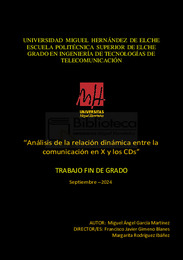Please use this identifier to cite or link to this item:
https://hdl.handle.net/11000/33914Análisis de la relación dinámica entre la comunicación en X y los CDs
| Title: Análisis de la relación dinámica entre la comunicación en X y los CDs |
| Authors: García Martínez, Miguel Ángel |
| Tutor: Gimeno Blanes, Francisco Javier Rodríguez Ibáñez, Margarita |
| Editor: Universidad Miguel Hernández de Elche |
| Department: Departamentos de la UMH::Ingeniería de Comunicaciones |
| Issue Date: 2024-09 |
| URI: https://hdl.handle.net/11000/33914 |
| Abstract: En la era de la información, el análisis de datos y la predicción de comportamientos en los mercados financieros se han vuelto herramientas esenciales para inversores y analistas. Este proyecto se enfoca en desarrollar un modelo predictivo que analice la relación entre la actividad en X (Twitter) y los valores de los Credit Default Swaps (CDs) de diversas entidades financieras. Este estudio se centra en cuatro bancos europeos: Credit Suisse, Deutsche Bank, Commerzbank y Banca Monte dei Paschi di Siena, instituciones que han enfrentado desafíos financieros importantes en los últimos años. El análisis utiliza técnicas avanzadas de Procesamiento del Lenguaje Natural (NLP) y aprendizaje automático (ML) en Matlab, explorando cómo la actividad en redes sociales puede impactar en la percepción del riesgo financiero, reflejada en los Credit Default Swaps (CDS). Para llevar a cabo esta investigación, se utilizaron datos históricos de los CDs extraídos de la base de datos DataStream con tweets obtenidos mediante la API de antiguamente Twitter y la plataforma Graphext. El periodo de estudio abarca desde enero de 2017 hasta mayo de 2023. El desarrollo del modelo predictivo sigue varias etapas clave. Primero, se realizó un análisis de sentimiento de los tweets, clasificándolos en positivos, negativos o neutrales, lo que permite cuantificar las emociones expresadas en redes sociales respecto a las empresas analizadas. Posteriormente, se integraron estos datos con variables adicionales como la verificación de las cuentas de los usuarios y el número de seguidores para mejorar la relevancia del análisis. Finalmente, se utilizó información histórica de los CDS para entrenar el modelo y mejorar la precisión de las predicciones. El uso de Matlab como herramienta central del proyecto facilita el procesamiento de grandes volúmenes de datos y la ejecución de algoritmos complejos de predicción, dada su capacidad para manejar cálculos matemáticos intensivos y su amplia gama de herramientas de análisis. El enfoque metodológico aplicado incluye la tokenización y normalización de los tweets, el análisis de frecuencia e intensidad, y la implementación de modelos predictivos basados en técnicas estadísticas y de aprendizaje automático. Este proyecto busca proporcionar una base sólida para futuras investigaciones en el ámbito de la correlación entre redes sociales y los Credit Default Swaps, explorando cómo la comunicación en X puede tener un impacto en la percepción del riesgo crediticio de las entidades financieras. Además, el estudio ofrece una herramienta útil para entender la relación entre eventos críticos y las fluctuaciones en los CDS, con el fin de predecir comportamientos anómalos en los mercados financieros. In the information age, data analysis and the prediction of behaviour in financial markets have become essential tools for investors and analysts. This project focuses on developing a predictive model that analyses the relationship between activity on X (Twitter) and the values of Credit Default Swaps (CDs) of various financial institutions. This study focuses on four European banks: Credit Suisse, Deutsche Bank, Commerzbank and Banca Monte dei Paschi di Siena, institutions that have faced significant financial challenges in recent years. The analysis uses advanced Natural Language Processing (NLP) and machine learning (ML) techniques in Matlab, exploring how social media activity can impact the perception of financial risk, as reflected in Credit Default Swaps (CDS). To conduct this research, we used historical CD data extracted from the DataStream database with tweets obtained through the former Twitter API and the Graphext platform. The study period spans from January 2017 to May 2023. The development of the predictive model follows several key steps. First, a sentiment analysis of the tweets was performed, classifying them as positive, negative or neutral, which allows us to quantify the emotions expressed on social networks with respect to the companies analysed. Subsequently, this data was integrated with additional variables such as user account verification and number of followers to improve the relevance of the analysis. Finally, historical information from the CDS was used to train the model and improve the accuracy of the predictions. The use of Matlab as the central tool of the project facilitates the processing of large volumes of data and the execution of complex prediction algorithms, given its capacity to handle intensive mathematical calculations and its wide range of analysis tools. The methodological approach applied includes tokenisation and normalisation of tweets, frequency and intensity analysis, and the implementation of predictive models based on statistical and machine learning techniques. This project aims to provide a solid basis for future research in the area of the correlation between social networks and Credit Default Swaps, exploring how communication on X can have an impact on the perception of credit risk of financial institutions. In addition, the study offers a useful tool for understanding the relationship between critical events and CDS fluctuations, in order to predict abnormal behaviour in financial markets. |
| Keywords/Subjects: redes sociales X (Twitter) Creadit Default Swaps (CDS) Procesamiento del Lenguaje Natural (NLP) aprendizaje automático (machine learning) |
| Knowledge area: CDU: Ciencias aplicadas: Ingeniería. Tecnología |
| Type of document: info:eu-repo/semantics/bachelorThesis |
| Access rights: info:eu-repo/semantics/openAccess Attribution-NonCommercial-NoDerivatives 4.0 Internacional |
| Appears in Collections: TFG- Ingeniería de Tecnologías de Telecomunicación |
.png)

